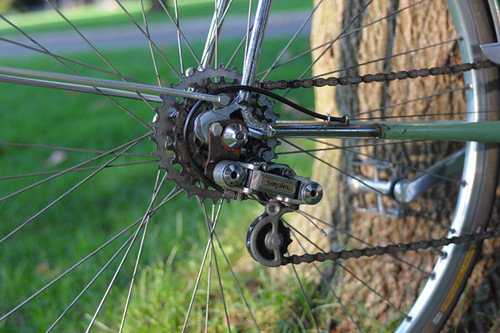There is no story of a great feat or feet in this case. Just a caution and a a little jubilation of getting away unscathed, again. And another lesson. learned or relearned, taught by a hard, but incredibly beautiful mistress. No technical difficulties to over come or one arm pull ups involved. It happens every day, all year long, in Chamonix. For myself and my partners on this tripjust a small part of a bigger adventure this winter.
I was lucky enough to climb most of Feb, March and a tiny bit in April this year in Chamonix. That after starting the ice season earlier than ever in Nov. in Canada and then Montana and back to Canada again in Jan. And the season isn't done yet. Hopefully I'll get another month yet in Canada again before everything has fallen down.
In all that ice climbing I have used dbl boots once this winter in NA (Canada) and on fourclimbs in the Alps.
But more than once I have regretted my choice in footwear. Never while wearing dbl boots however.
No one dislikes climbing in dbl boots more than I do. They (any of the three best currently available) are big, and bulky and heavy in comparison to the single boots I am using. The up side to that is they offer more support for your calfs and feet and more protection from the pounding endurance alpine ice will give your toes. All that before you get to the added warmth they offer and the added benefits of a dbl boot drying out in a bivy.
Check out the climbers on the S. Face of the Midi.

And for perspective the little bump in the middle of the Massif which was our school room on several occasions. The Cosmic Arete is the sky line ridge, left to right. S. Face of the Midi is the clean wall on the right.

Duringlate Feb and early March in Chamonix my partners and I kept getting bounced between -20 temps or lowerand 20+ cm dumps of new snow up high. All that while trying to get acclimatized on the Midi at 12391 feet(
3777 m).
Most every chance I got I would hop on the Midi tram and head to 12K feet or at least to 10K on the GM lift. For a flat lander coming straight from sea level there were some painful days in all that. And the GM had a better lunch :)
One of our first adventures was a little trip out the tunnel on the Midi in a wind storm after a 15 to 25cm dump of snow. The first lift on the tram was late as is typical after new snow but I was pressing to get some climbing in. At that point I was 7 days into a 44 day trip and not done any climbing yet. But the skiing was good :)

In crotch deep new snow (so much for the 15cm) before we even hit the end of the rope hand rail on the Midi arete Josh's noise was white withskin freezing up. It was cold and the wind was whipping. Hard to judge just how cold it would be at 12K from our apartment in town. (and that got only slightly easier in the next month) Josh was smart to turn around as his Rudolf's nosedeclared for the next week or so. He got revenge by coming back on a still and blue bird day for his solo climb as we road the lift down off the mtn.
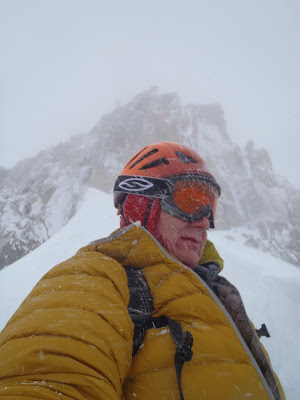
Matt and I continud and ventured off to "look" at the Cosmic Arete. Two French parties were held up in the old worker's hut at teh basse of the ridge out of the wind. The sun felt good and Matt and I thought, "why not take a look". After all how hard could it be?
Mind you the last tram down is at 4:30 and we didn't even get off the tram till after noon...so the real question should have been, "just how fast are we?"
In good conditions the Cosmic Arete is a awesome alpine romp that generally takes an hr or so. We hit the Midi platform at 5:30 that afternoon. More to that story but not the point thsi time out.

-20C (around -5F) and a strong wind can be pretty cold. At 12K feet it is cold even in the sun if you are not acclimatized. By the time we got to the last 4 pitches of climbing I was full on shivering even in a MEC Tango belay jacket over a Atom LT and two hoodies. Thankfully my feet we not yet cold. I was wearing a pair of Scarpa Ultra single boots. But it was obvious to me that when my feet did get cold...and it was just a matter of time....I would be totally FOOKED. Quick way to end a climbing trip, that.

The good news was the last 4 pitches were excellent and funclimbing in most any conditions, even that particular day. And thankfully no more trail breaking in deep snow. My feet were out of the snow for the most part and my core was finally warming up again from the effort of easy technical climbing.
 I made myself a promise after thatfirst climb...."always bring full face goggles and always wear my dbl boots up high here".
I made myself a promise after thatfirst climb...."always bring full face goggles and always wear my dbl boots up high here".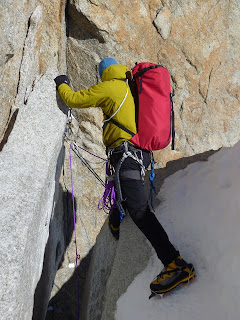
Of course I failed to keep that promise
and regretted it every, single, time.By the end of my trip it was early April. Things had warmed considerably up high aroundChamonix.
More storms were rolling through the mountains by the end as well. The power of a good storm in the Alps rivals anything I have seen in Alaska. Impressive. Scary if you have to be out in it.
There is a reason for all the huts in the Alps. Getting caught out in those conditions with out brick and mortar around you, canjust aseasily kill you. The final storm we weathered at the Cosmic Hut would have, if you had been unprotected onroute.

The obviously now happy campers leaving the upper tram terminal after being stuck on the Midi for two days..

When the final tally was made and the tram started down again on day three, half of the 20 passengers were French Mountain Police and Chamonix Guides. Bad weather can catch anyone, even the most experienced. I counted. There were 4 pairs of single boots in the crowd. I felt terribly under dressed. And happy I had a hut and WC to hid in for ourtime up high. Spantiks weren't a fashion statement there...but a survival tool.



It is all about conditions, isn't it :)



























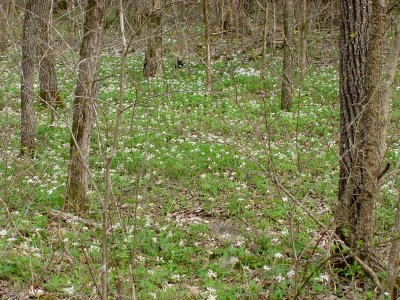


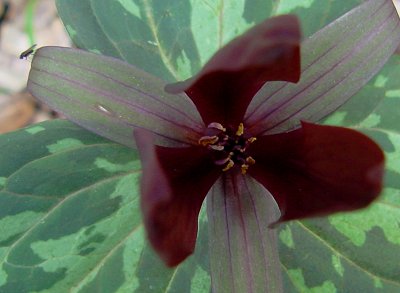










 Pine Tree Arch.
Pine Tree Arch. Tunnel Arch.
Tunnel Arch. There were several groups of school kids on the trail.
There were several groups of school kids on the trail. Landscape Arch, taken at an angle to get the entire length in one shot, even then I didn't get the ends of it completely. At 310 feet long (with a 290 foot span), it is reportedly the longest freestanding natural arch known to exist. At its thinnest point it is only six feet thick. When I visited the park in 1979 there was a trail where you could walk under the arch. (Somewhere, I have a photo from that trip that shows someone walking on the arch!) It has become more fragile with age, and several large chunks fell off in 1995, so for safety reasons and to help preserve it a little longer they closed the trail that went underneath the arch.
Landscape Arch, taken at an angle to get the entire length in one shot, even then I didn't get the ends of it completely. At 310 feet long (with a 290 foot span), it is reportedly the longest freestanding natural arch known to exist. At its thinnest point it is only six feet thick. When I visited the park in 1979 there was a trail where you could walk under the arch. (Somewhere, I have a photo from that trip that shows someone walking on the arch!) It has become more fragile with age, and several large chunks fell off in 1995, so for safety reasons and to help preserve it a little longer they closed the trail that went underneath the arch. There was a bit of a bottleneck with the school kids traversing the rocks. The trail split a short distance ahead. They went one way and I went the other!
There was a bit of a bottleneck with the school kids traversing the rocks. The trail split a short distance ahead. They went one way and I went the other! A southwest view of the valley from near Navajo Arch.
A southwest view of the valley from near Navajo Arch. The valley view through Partition Arch, looking east.
The valley view through Partition Arch, looking east. A portion of the trail went along the top of a fin, with the “added bonus” of several rocks on top, which provided challenging obstacles. It was about 25-30 feet to the ground.
A portion of the trail went along the top of a fin, with the “added bonus” of several rocks on top, which provided challenging obstacles. It was about 25-30 feet to the ground. Fins alongside the trail.
Fins alongside the trail.
